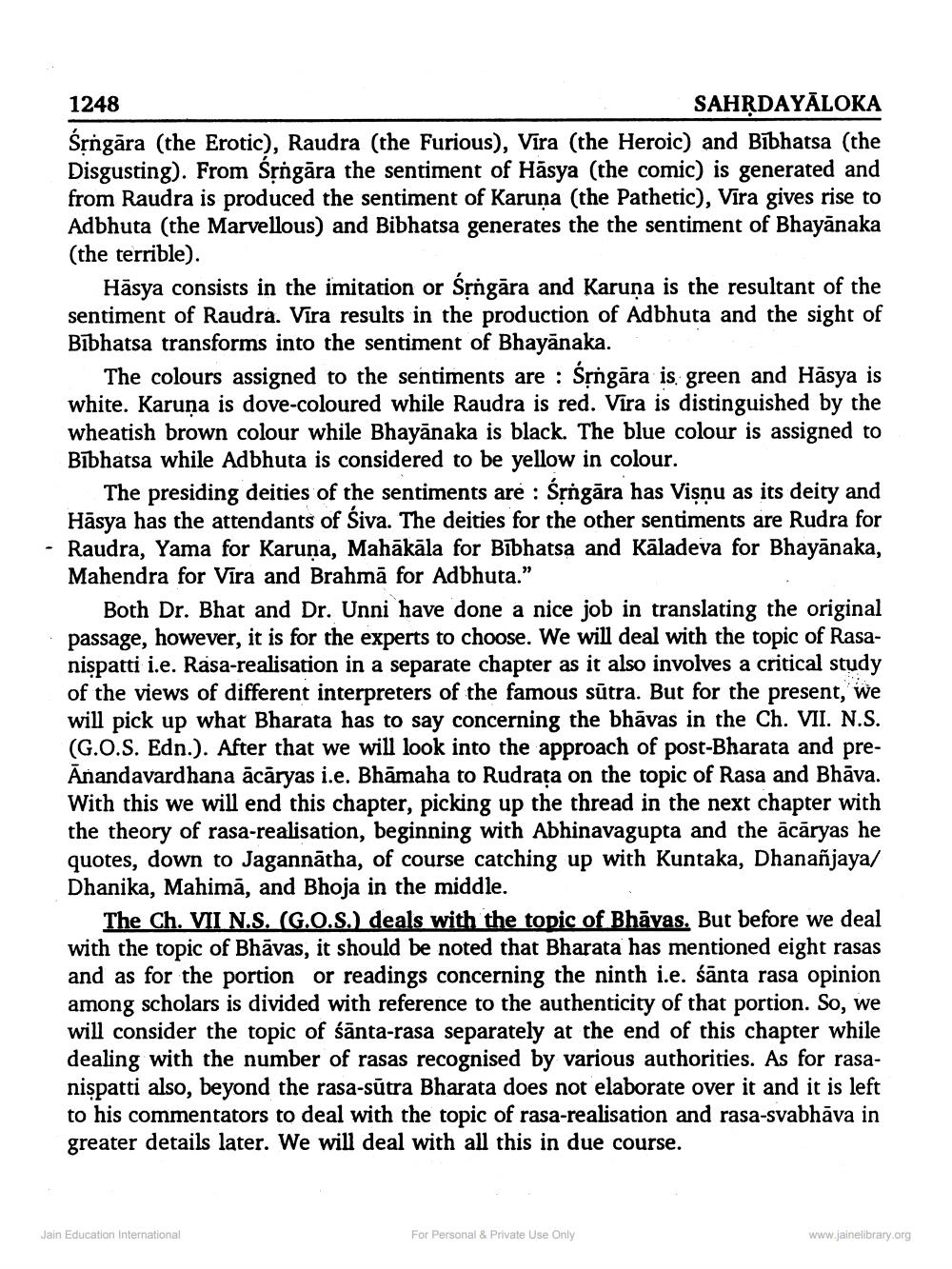________________
1248
SAHRDAYĀLOKA Srngāra (the Erotic), Raudra (the Furious), Vira (the Heroic) and Bibhatsa (the Disgusting). From Srngāra the sentiment of Hāsya (the comic) is generated and from Raudra is produced the sentiment of Karuna (the Pathetic), Vira gives rise to Adbhuta (the Marvellous) and Bibhatsa generates the the sentiment of Bhayānaka (the terrible).
Hāsya consists in the imitation or Śrngāra and Karuna is the resultant of the sentiment of Raudra. Vira results in the production of Adbhuta and the sight of Bībhatsa transforms into the sentiment of Bhayānaka.
The colours assigned to the sentiments are : śrngāra is green and Hāsya is white. Karuna is dove-coloured while Raudra is red. Vira is distinguished by the wheatish brown colour while Bhayānaka is black. The blue colour is assigned to Bībhatsa while Adbhuta is considered to be yellow in colour.
The presiding deities of the sentiments are : śộngāra has Vişnu as its deity and Hāsya has the attendants of Siva. The deities for the other sentiments are Rudra for - Raudra, Yama for Karuna, Mahākāla for Bībhatsa and Kāladeva for Bhayānaka, Mahendra for Vira and Brahmā for Adbhuta."
Both Dr. Bhat and Dr. Unni have done a nice job in translating the original · passage, however, it is for the experts to choose. We will deal with the topic of Rasa
nispatti i.e. Rasa-realisation in a separate chapter as it also involves a critical study of the views of different interpreters of the famous sūtra. But for the present, we will pick up what Bharata has to say concerning the bhāvas in the Ch. VII. N.S. (G.O.S. Edn.). After that we will look into the approach of post-Bharata and preAnandavardhana ācāryas i.e. Bhāmaha to Rudrata on the topic of Rasa and Bhāva. With this we will end this chapter, picking up the thread in the next chapter with the theory of rasa-realisation, beginning with Abhinavagupta and the ācāryas he quotes, down to Jagannātha, of course catching up with Kuntaka, Dhananjaya/ Dhanika, Mahimā, and Bhoja in the middle.
The Ch. VII N.S. (G.O.S.) deals with the topic of Bhāvas. But before we deal with the topic of Bhāvas, it should be noted that Bharata has mentioned eight rasas and as for the portion or readings concerning the ninth i.e. śānta rasa opinion among scholars is divided with reference to the authenticity of that portion. So, we will consider the topic of śānta-rasa separately at the end of this chapter while dealing with the number of rasas recognised by various authorities. As for rasanispatti also, beyond the rasa-sūtra Bharata does not elaborate over it and it is left to his commentators to deal with the topic of rasa-realisation and rasa-svabhāva in greater details later. We will deal with all this in due course.
Jain Education International
For Personal & Private Use Only
www.jainelibrary.org




